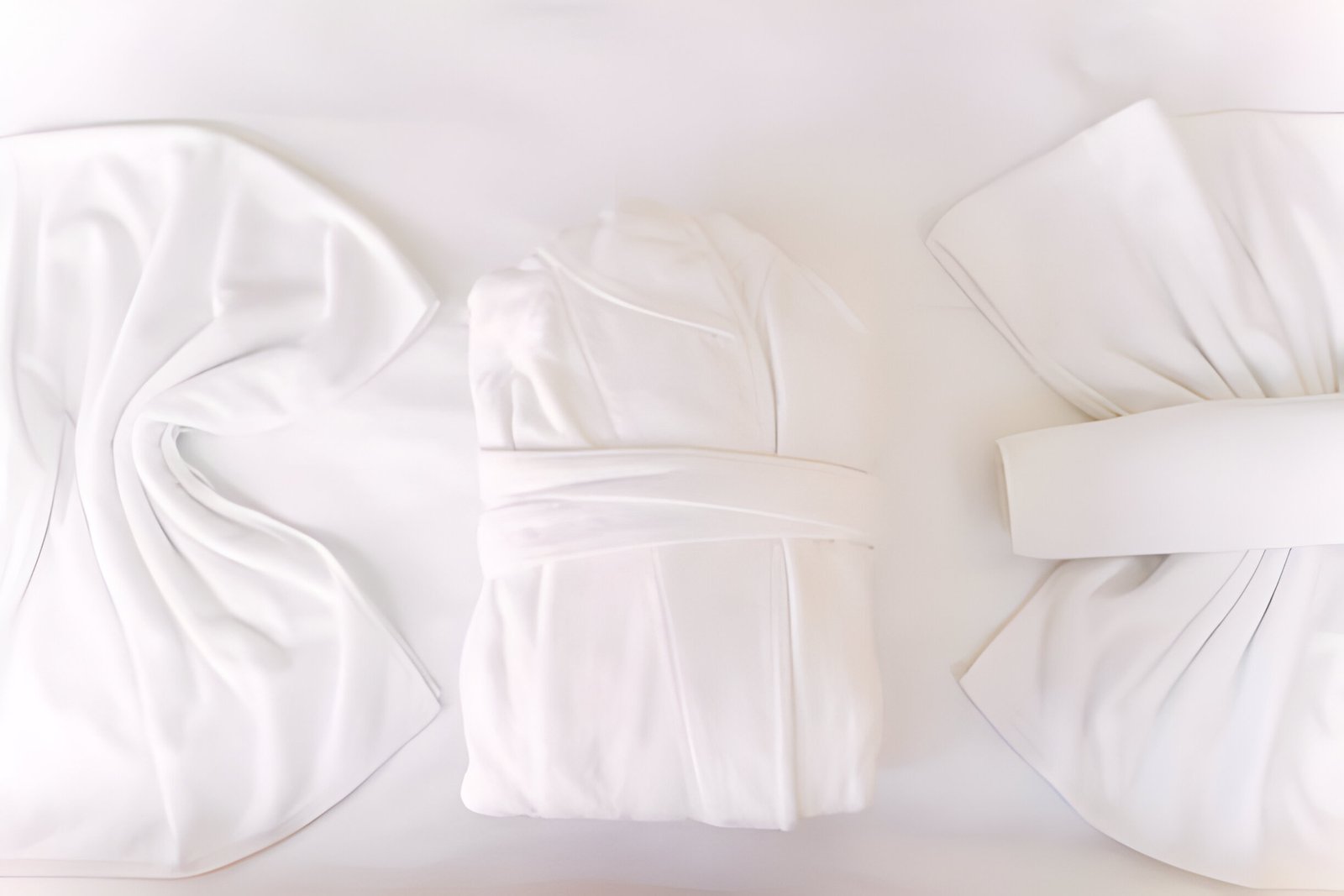Image Credit: Getty image
Navigating the world of bath linens, particularly the debate around bath sheet vs bath towel, reveals much more than a simple choice of bathroom textiles. This comparison touches on essential aspects such as material, dimensions, absorbency, and even bathroom storage possibilities. It’s a decision that affects not only the plushness and efficacy of drying after a bath but also how we optimize space on our towel racks and in linen closets. Understanding the key differences between these two items is crucial for anyone looking to enhance their post-bath experience, ensuring they select the right product that suits their needs for comfort, convenience, and luxury in hair drying and body wrap functionalities.
The forthcoming sections will delve into the specifics of what sets a bath sheet apart from a bath towel, including their distinctive features such as size, weight, and overall usage including as a beach towel or for more efficient hair drying. Discussed in detail will be the material advantages, the impact of dimensions on absorbency and ease of use, and how each fits into everyday bathroom routines—from hanging on a towel rack to folding for bathroom storage. This exploration aims to guide readers through the bath sheet vs bath towel quandary, aiding in an informed decision whether looking for something lightweight and compact or plush and enveloping. Ultimately, providing clarity on the bath sheet vs. bath towel debate is our goal, helping you decide which is best suited for your lifestyle and home.
What is a Bath Sheet?
Bath sheets are the epitome of luxury in the world of bath linens, offering superior coverage, comfort, and absorbency. They are larger than bath towels, making them ideal for those who appreciate a spa-like experience at home. Here, we explore the key aspects of bath sheets, including their size, material, advantages, and some considerations.
Size and Dimensions
Bath sheets are significantly larger than traditional bath towels, typically measuring between 35 to 40 inches wide and 60 to 70 inches long. This extra size allows for more comprehensive coverage, making it easy to wrap the body fully after a shower or bath. The generous dimensions not only enhance comfort but also improve the functionality of the towel in drying and warmth retention.
Material and Texture
The material of a bath sheet greatly influences its texture, absorbency, and durability. High-quality bath sheets are often made from luxurious materials like Turkish or Egyptian cotton, known for their long fibers that create a soft, plush feel. These materials are highly absorbent and quick-drying, providing an excellent balance between functionality and luxury. Some bath sheets also feature a looped terry cloth design, which enhances their ability to absorb moisture efficiently.
Pros of Using Bath Sheets
One of the primary benefits of bath sheets is their large size, which offers enhanced absorbency and coverage. This makes them perfect for individuals who find regular bath towels too small or insufficient. Bath sheets envelop the body comfortably, offering a warm and cozy experience that elevates the simple act of drying off into a moment of luxury. Additionally, their plush material can make every bath feel like a visit to a high-end spa.
Cons of Using Bath Sheets
Despite their advantages, bath sheets also come with some drawbacks. Their larger size means they require more space for storage, whether in a linen closet or on a towel rack. They also tend to be more expensive than regular bath towels, reflecting their larger size and often higher-quality material. Furthermore, due to their substantial fabric, bath sheets can take longer to dry, which might be a consideration in humid environments or for those with limited drying space.
In summary, bath sheets offer a luxurious and enveloping drying experience, ideal for those who value comfort and coverage. However, their size and cost might require some consideration depending on individual needs and space constraints.
What is a Bath Towel?
Bath towels are essential items in every bathroom, combining functionality with comfort. They play a crucial role in daily hygiene routines, quickly drying the body and hair after showers or baths. Here, we explore the key features of bath towels, including their size, material, advantages, and some considerations.
Size and Dimensions
Bath towels typically range in size from 20 x 40 inches to 30 x 58 inches. This size variation ensures that they are large enough to dry off effectively while being manageable to handle and store. The dimensions are designed to provide ample coverage for the average adult body, making them practical for everyday use.
Material and Texture
The majority of bath towels are crafted from cotton due to its softness, absorbency, and durability. Varieties like Egyptian and Turkish cotton are highly prized for their superior plushness and quick-drying capabilities. Bath towels may also incorporate blends such as cotton-polyester to enhance their strength and decrease drying times. The texture of the towels can vary from ultra-plush to lightweight, catering to different preferences and needs.
Pros of Using Bath Towels
Bath towels offer several benefits. They are highly absorbent, making them effective at drying the body quickly and efficiently. Their soft texture provides a comfortable and luxurious feel against the skin, enhancing the bathing experience. Additionally, bath towels are versatile, used not only for drying but also as wraps or makeshift cushions. They are designed to withstand frequent washes, maintaining their texture and absorbency over time.
Cons of Using Bath Towels
Despite their benefits, there are some drawbacks to using bath towels. They require regular laundering to prevent the buildup of bacteria and odors, especially in damp environments. Larger towels may take longer to dry and need more storage space, which could be a concern in smaller bathrooms. Furthermore, high-quality bath towels can be more expensive, representing a higher initial investment compared to lower-quality options.
Understanding these aspects of bath towels helps in choosing the right type for personal use, balancing practicality with luxury to enhance the bathing experience.
Key Differences Between Bath Sheets and Bath Towels
Size Comparison
Bath sheets typically measure around 35 to 70 inches, offering significantly more coverage compared to bath towels, which generally measure approximately 27 by 52 inches. This size difference not only affects the wrapping comfort but also impacts the space they occupy when stored or hung.
Cost Comparison
Due to the larger size and the increased amount of material used, bath sheets are often more expensive than bath towels. Typically, one might spend an additional $10 to $20 on a bath sheet compared to a bath towel. This makes bath towels a more budget-friendly option for those who prioritize cost over size.
Absorbency and Drying Time
Bath sheets, with their larger surface area, are more absorbent than bath towels. This can be particularly beneficial for those who prefer a more luxurious and thorough drying experience. However, the added absorbency results in longer drying times for bath sheets, which may not be ideal in humid climates or for quick turnarounds in bathroom routines.
Convenience of Use
Bath towels, being smaller and lighter, are typically easier to handle, wash, and dry. They are more convenient for daily use, travel, and gym visits, as they take up less space in a bag and laundry loads. Conversely, bath sheets, while luxurious, can be bulky and cumbersome, making them less ideal for compact living situations or quick drying needs. They are better suited for leisurely uses at home or in settings where comfort and coverage are prioritized over convenience.
Which One Should You Choose?
Choosing between a bath sheet and a bath towel largely depends on individual preferences and specific needs. Here are some considerations to help make an informed decision:
Factors to Consider
When deciding between a bath sheet and a bath towel, consider the following:
- Space: Bath sheets are larger and require more storage space. Assess your bathroom storage and towel rack space to determine if a bath sheet can be accommodated without clutter.
- Budget: Bath sheets are generally more expensive due to their size and the amount of material used. Consider your budget and how much you are willing to invest in bath linens.
- Drying Time: If you live in a humid environment or need a towel that dries quickly, a bath towel might be more practical as it has a shorter drying time compared to a bath sheet.
Best for Different Scenarios
- Home Use: If you prefer a luxurious and enveloping experience after a shower, a bath sheet may be the best choice. It’s ideal for those who value comfort and coverage.
- Gym or Travel: For those who are always on the go, bath towels are more practical. They are easier to carry and dry faster, making them suitable for frequent use outside the home.
User Preferences
Ultimately, the choice between a bath sheet and a bath towel comes down to personal preference:
- Comfort and Coverage: If you prioritize comfort and full coverage, a bath sheet is suitable as it allows you to wrap yourself completely.
- Ease of Use and Practicality: If you prefer a towel that is easy to handle, store, and dries quickly, a bath towel would be the better option.
Each option offers distinct benefits, and the right choice will depend on what aspects of towel usage are most important to you. Whether it’s the plush luxury of a bath sheet or the practical efficiency of a bath towel, both serve their purposes well in different contexts.
Conclusion
Throughout this exploration, we’ve navigated the nuanced differences and considerations between bath sheets and bath towels, touching on aspects such as size and dimensions, material and texture, alongside their respective advantages and considerations for use. This discussion underlines the importance of choosing the right option based on individual needs, preferences, and the practicalities of one’s own lifestyle and space. By examining the key distinctions—from absorbency and plushness to storage requirements and cost implications—we’ve aimed to equip readers with the knowledge necessary to make an informed choice that enhances their bathing experience and complements their home environment.
The choice between a bath sheet and a bath towel is ultimately a personal one, informed by weighing the benefits of luxury and coverage against the practicalities of space and speed of drying. Whether you lean towards the enveloping comfort of a bath sheet or the convenience and practicality of a bath and towel, understanding your own priorities is key. By considering the insights provided, readers can confidently select a product that not only meets their specific need for comfort and functionality but also adds a touch of personal preference and luxury to their daily routines.
FAQs
1. How do bath sheets differ from bath towels in terms of size?
Bath sheets are generally about 50% larger than bath towels. Typically, bath towels are made to be about 25-31 inches wide and 52-58 inches long. In contrast, bath sheets usually measure around 35-40 inches wide and 60-70 inches long.
2. What are the intended uses of a bath towel compared to a bath sheet?
A bath towel is primarily used for drying your body after taking a shower. It is sufficiently large to wrap around your body and absorb the moisture from your skin. Conversely, a bath sheet also serves the purpose of drying off after a shower but offers more coverage due to its larger size.
3. Do hotels prefer to use bath towels or bath sheets?
Luxury and boutique hotels often opt to provide larger towels for drying off, which can include bigger-than-average bath towels or standard-sized bath sheets, enhancing the guest’s comfort and experience.
4. What distinguishes a bathrobe from a bath towel?
A bathrobe serves more as a garment for comfort and privacy rather than for drying. It is typically used to cover the body during times when one is not fully dressed, such as after showering and before getting dressed, providing a cozy transition while maintaining privacy.
























+ There are no comments
Add yours